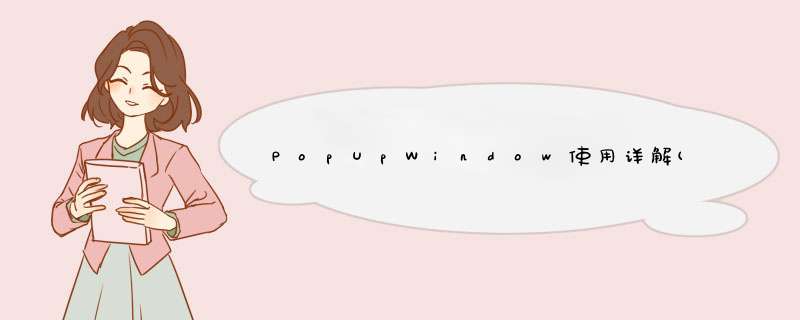
上篇为大家基本讲述了有关PopupWindow的基本使用,但还有几个相关函数还没有讲述,我们这篇将着重看看这几个函数的用法并结合源码来讲讲具体原因,最后是有关PopupWindow在使用时的疑问,给大家讲解一下。
一、常用函数讲解
这段将会给大家讲下下面几个函数的意义及用法,使用上篇那个带背景的例子为基础。
public voID settouchable(boolean touchable)public voID setFocusable(boolean focusable)public voID setoutsIDetouchable(boolean touchable)public voID setBackgroundDrawable(Drawable background)设置PopupWindow是否响应touch事件,默认是true,如果设置为false,即会是下面这个结果:(所有touch事件无响应,包括点击事件)
对应代码:
private voID showPopupWindow() { VIEw contentVIEw = LayoutInflater.from(MainActivity.this).inflate(R.layout.popuplayout,null); mPopWindow = new PopupWindow(contentVIEw); mPopWindow.setWIDth(VIEwGroup.LayoutParams.FILL_PARENT); mPopWindow.setHeight(VIEwGroup.LayoutParams.FILL_PARENT); mPopWindow.settouchable(false); ………………//单项点击 mPopWindow.showAsDropDown(mMenuTv);}该函数的意义表示,PopupWindow是否具有获取焦点的能力,默认为False。一般来讲是没有用的,因为普通的控件是不需要获取焦点的,而对于EditText则不同,如果不能获取焦点,那么EditText将是无法编辑的。
所以,我们在popuplayout.xml最底部添加一个EditText,分别演示两段不同的代码,即分别将setFocusable设置为false和设置为true;看看有什么不同:
(1)setFocusable(true)
代码如下:
private voID showPopupWindow() { VIEw contentVIEw = LayoutInflater.from(MainActivity.this).inflate(R.layout.popuplayout,null); mPopWindow = new PopupWindow(contentVIEw); mPopWindow.setWIDth(VIEwGroup.LayoutParams.FILL_PARENT); mPopWindow.setHeight(VIEwGroup.LayoutParams.FILL_PARENT); //是否具有获取焦点的能力 mPopWindow.setFocusable(true); …………//各item点击响应 mPopWindow.showAsDropDown(mMenuTv);}明显在点击EditText的时候,会d出编辑框。
(2)setFocusable(false)
同样上面一段代码,那我们将setFocusable设置为false,会是怎样呢?
private voID showPopupWindow() { VIEw contentVIEw = LayoutInflater.from(MainActivity.this).inflate(R.layout.popuplayout,null); mPopWindow = new PopupWindow(contentVIEw); mPopWindow.setWIDth(VIEwGroup.LayoutParams.FILL_PARENT); mPopWindow.setHeight(VIEwGroup.LayoutParams.FILL_PARENT); //是否具有获取焦点的能力 mPopWindow.setFocusable(false); …………//各item点击响应 mPopWindow.showAsDropDown(mMenuTv);}效果图下:
可见,点击EditText没有出现任何反应!所以如果PopupWindow没有获取焦点的能力,那么它其中的EditText当然是没办法获取焦点的,EditText无法获取焦点,那对它而言整个EditText控件就是不可用的。
3、setoutsIDetouchable(boolean touchable)
这个函数的意义,就是指,PopupWindow以外的区域是否可点击,即如果点击PopupWindow以外的区域,PopupWindow是否会消失。
下面这个是点击会消息的效果图:
看看它对应的代码:
private voID showPopupWindow() { VIEw contentVIEw = LayoutInflater.from(MainActivity.this).inflate(R.layout.popuplayout,null); mPopWindow = new PopupWindow(contentVIEw); mPopWindow.setWIDth(VIEwGroup.LayoutParams.FILL_PARENT); mPopWindow.setHeight(VIEwGroup.LayoutParams.FILL_PARENT); //外部是否可以点击 mPopWindow.setBackgroundDrawable(new BitmapDrawable()); mPopWindow.setoutsIDetouchable(true); …………//各ITEM点击响应 mPopWindow.showAsDropDown(mMenuTv); }这里要非常注意的一点:
mPopWindow.setBackgroundDrawable(new BitmapDrawable());mPopWindow.setoutsIDetouchable(true);大家可能要疑问,为什么要加上mPopWindow.setBackgroundDrawable(new BitmapDrawable());这句呢,从代码来看没并没有真正设置Bitmap,而只是new了一个空的bitmap,好像并没起到什么作用。那如果我们把这句去掉会怎样:
把代码改成这样子:(只使用setoutsIDetouchable)
private voID showPopupWindow() { VIEw contentVIEw = LayoutInflater.from(MainActivity.this).inflate(R.layout.popuplayout,null); mPopWindow = new PopupWindow(contentVIEw); mPopWindow.setWIDth(VIEwGroup.LayoutParams.FILL_PARENT); mPopWindow.setHeight(VIEwGroup.LayoutParams.FILL_PARENT); //外部是否可以点击 mPopWindow.setoutsIDetouchable(true); …………//各ITEM点击响应 mPopWindow.showAsDropDown(mMenuTv);}看到了没,点击外部没反应………………这就有点坑了,至于原因,我们在setBackgroundDrawable()中讲。
4、setBackgroundDrawable(Drawable background)
这个函数可是吊了,这个函数不只能设置背景……,因为你加上它之后,setoutsIDetouchable()才会生效;
而且,只有加上它之后,PopupWindow才会对手机的返回按钮有响应:即,点击手机返回按钮,可以关闭PopupWindow;如果不加setBackgroundDrawable()将关闭的PopupWindow所在的Activity.
这个函数要怎么用,这里应该就不用讲了吧,可以填充进去各种Drawable,比如new BitmapDrawable(),new colorDrawable(),等;
我们这里主要从源码的角度来看看setBackgroundDrawable()后,PopupWindow都做了些什么。
首先看看setBackgroundDrawable(),将传进去的background赋值给mBackground;
voID setBackgroundDrawable(Drawable background) { mBackground = background;}然后再看看显示showAsDropDown()显示的时候,都做了些什么。代码如下:
public voID showAsDropDown(VIEw anchor,int xoff,int yoff) { ………… //准备窗口 WindowManager.LayoutParams p = createPopupLayout(anchor.getwindowToken()); preparePopup(p); ………… //显示窗口 invokePopup(p);}在这段代码中,先是准备窗口用来显示,然后再利用invokePopup()来显示窗体。
我们看看在preparePopup(p)中是怎么准备窗体的:
private voID preparePopup(WindowManager.LayoutParams p) { if (mBackground != null) { final VIEwGroup.LayoutParams layoutParams = mContentVIEw.getLayoutParams(); int height = VIEwGroup.LayoutParams.MATCH_PARENT; if (layoutParams != null && layoutParams.height == VIEwGroup.LayoutParams.WRAP_CONTENT) { height = VIEwGroup.LayoutParams.WRAP_CONTENT; } // when a background is available,we embed the content vIEw // within another vIEw that owns the background drawable PopupVIEwContainer popupVIEwContainer = new PopupVIEwContainer(mContext); PopupVIEwContainer.LayoutParams ListParams = new PopupVIEwContainer.LayoutParams( VIEwGroup.LayoutParams.MATCH_PARENT,height ); popupVIEwContainer.setBackgroundDrawable(mBackground); popupVIEwContainer.addVIEw(mContentVIEw,ListParams); mPopupVIEw = popupVIEwContainer; } else { mPopupVIEw = mContentVIEw; } mPopupWIDth = p.wIDth; mPopupHeight = p.height;}从上面可以看出,如果mBackground不这空,会首先生成一个PopupVIEwContainer的VIEwContainer,然后把mContentVIEw做为子布局add进去,然后把popupVIEwContainer做为PopupWindow做为根布局。
popupVIEwContainer.addVIEw(mContentVIEw,ListParams);那如果mBackground不为空,那就直接把mContentVIEw做为VIEw传递给PopupWindow窗体。
mPopupVIEw = mContentVIEw到此,我们知道,如果mBackground不为空,会在我们设置的contentVIEw外再包一层布局。
那下面,我们再看看包的这层布局都干了什么:
先列出来完整的代码,然后再分步讲(已做精简,如需知道更多,可参看源码)
private class PopupVIEwContainer extends FrameLayout { private static final String TAG = "PopupWindow.PopupVIEwContainer"; public PopupVIEwContainer(Context context) { super(context); } ………… @OverrIDe public boolean dispatchKeyEvent(KeyEvent event) { if (event.getKeyCode() == KeyEvent.KEYCODE_BACK) { if (event.getAction() == KeyEvent.ACTION_DOWN && event.getRepeatCount() == 0) { ………… } else if (event.getAction() == KeyEvent.ACTION_UP) { KeyEvent.dispatcherState state = getKeydispatcherState(); if (state != null && state.isTracking(event) && !event.isCanceled()) { dismiss(); return true; } } return super.dispatchKeyEvent(event); } else { return super.dispatchKeyEvent(event); } } @OverrIDe public boolean ontouchEvent(MotionEvent event) { final int x = (int) event.getX(); final int y = (int) event.getY(); if ((event.getAction() == MotionEvent.ACTION_DOWN) && ((x < 0) || (x >= getWIDth()) || (y < 0) || (y >= getHeight()))) { dismiss(); return true; } else if (event.getAction() == MotionEvent.ACTION_OUTSIDE) { dismiss(); return true; } else { return super.ontouchEvent(event); } } …………}这里总共需要注意三部分:
(1)、PopupVIEwContainer派生自FrameLayout
从PopupVIEwContainer声明上可以看到,PopupVIEwContainer派生自FrameLayout;所以,这也是它能将我们传进来的contentVIEw添加为自己的子布局的原因。
(2)、返回按钮捕捉
public boolean dispatchKeyEvent(KeyEvent event) { if (event.getKeyCode() == KeyEvent.KEYCODE_BACK) { if (event.getAction() == KeyEvent.ACTION_DOWN && event.getRepeatCount() == 0) { ………… } else if (event.getAction() == KeyEvent.ACTION_UP) { //抬起手指时 KeyEvent.dispatcherState state = getKeydispatcherState(); if (state != null && state.isTracking(event) && !event.isCanceled()) { //隐藏窗体 dismiss(); return true; } } return super.dispatchKeyEvent(event); } else { return super.dispatchKeyEvent(event); }}从上面的代码来看,PopupVIEwContainer捕捉了KeyEvent.KEYCODE_BACK事件,并且在用户在点击back按钮,抬起手指的时候(event.getAction() == KeyEvent.ACTION_UP)将窗体隐藏掉。
所以,添加上mBackground以后,可以在用户点击返回按钮时,隐藏窗体!
(3)、捕捉touch事件——ontouchEvent
public boolean ontouchEvent(MotionEvent event) { final int x = (int) event.getX(); final int y = (int) event.getY(); if ((event.getAction() == MotionEvent.ACTION_DOWN) && ((x < 0) || (x >= getWIDth()) || (y < 0) || (y >= getHeight()))) { dismiss(); return true; } else if (event.getAction() == MotionEvent.ACTION_OUTSIDE) { dismiss(); return true; } else { return super.ontouchEvent(event); }}从这代码来看,PopupVIEwContainer捕捉了两种touch事件,MotionEvent.ACTION_DOWN和MotionEvent.ACTION_OUTSIDE;将接收到这两个事件时,会将窗体隐藏掉。
MotionEvent.ACTION_DOWN的触发很好理解,即当用户点击到PopupVIEwContainer事件时,就隐藏掉;
所以,下面的情况就来了:
假如有一个TextVIEw,我们没有对它设置点击响应。那只要加了background,那点击事件就会传给下层的PopupVIEwContainer,从而使窗体消失。
那还有个问题,MotionEvent.ACTION_OUTSIDE是个什么鬼?它是怎么触发的。我们在下面开一段细讲。
(4)MotionEvent.ACTION_OUTSIDE与setoutsIDetouchable(boolean touchable)
可能把这两个放在一块,大家可能就恍然大悟了,表着急,一个个来看。
先看看setoutsIDetouchable(boolean touchable)的代码:
public voID setoutsIDetouchable(boolean touchable) { mOutsIDetouchable = touchable;}然后再看看mOutsIDetouchable哪里会用到
下面代码,我做了严重精减,等下会再完整再讲这一块
private int computeFlags(int curFlags) { curFlags &= ~(WindowManager.LayoutParams.FLAG_WATCH_OUTSIDE_touch); ………… if (mOutsIDetouchable) { curFlags |= WindowManager.LayoutParams.FLAG_WATCH_OUTSIDE_touch; } ………… return curFlags;}这段代码主要是用各种变量来设置window所使用的flag;
首先,将curFlags所在运算的各种Flag,全部置为False;代码如下:
curFlags &= ~(WindowManager.LayoutParams.FLAG_WATCH_OUTSIDE_touch);然后,再根据用户设置的变量来开启:
if (mOutsIDetouchable) { curFlags |= WindowManager.LayoutParams.FLAG_WATCH_OUTSIDE_touch;}既然讲到FLAG_WATCH_OUTSIDE_touch,那我们来看看FLAG_WATCH_OUTSIDE_touch所代表的意义:
这段话的意思是说,如果窗体设置了FLAG_WATCH_OUTSIDE_touch这个flag,那么 用户点击窗体以外的位置时,将会在窗体的MotionEvent中收到MotionEvetn.ACTION_OUTSIDE事件。
参见:《WindowManager.LayoutParams》
所以在PopupVIEwContainer中添加了对MotionEvent.ACTION_OUTSIDE的捕捉!当用户点击PopupVIEwContainer以外的区域时,将dismiss掉PopupWindow
public boolean ontouchEvent(MotionEvent event) { final int x = (int) event.getX(); final int y = (int) event.getY(); if ((event.getAction() == MotionEvent.ACTION_DOWN) && ((x < 0) || (x >= getWIDth()) || (y < 0) || (y >= getHeight()))) { dismiss(); return true; } else if (event.getAction() == MotionEvent.ACTION_OUTSIDE) { dismiss(); return true; } else { return super.ontouchEvent(event); }}(5)重看PopupWindow的computeFlags(int curFlags)函数
完整的computeFlags()函数如下:
private int computeFlags(int curFlags) { curFlags &= ~( WindowManager.LayoutParams.FLAG_IGnorE_CHEEK_PRESSES | WindowManager.LayoutParams.FLAG_NOT_FOCUSABLE | WindowManager.LayoutParams.FLAG_NOT_touchABLE | WindowManager.LayoutParams.FLAG_WATCH_OUTSIDE_touch | WindowManager.LayoutParams.FLAG_LAYOUT_NO_liMITS | WindowManager.LayoutParams.FLAG_ALT_FOCUSABLE_IM | WindowManager.LayoutParams.FLAG_SPliT_touch); if(mIgnoreCheekPress) { curFlags |= WindowManager.LayoutParams.FLAG_IGnorE_CHEEK_PRESSES; } if (!mFocusable) { curFlags |= WindowManager.LayoutParams.FLAG_NOT_FOCUSABLE; if (minputMethodMode == input_METHOD_NEEDED) { curFlags |= WindowManager.LayoutParams.FLAG_ALT_FOCUSABLE_IM; } } else if (minputMethodMode == input_METHOD_NOT_NEEDED) { curFlags |= WindowManager.LayoutParams.FLAG_ALT_FOCUSABLE_IM; } if (!mtouchable) { curFlags |= WindowManager.LayoutParams.FLAG_NOT_touchABLE; } if (mOutsIDetouchable) { curFlags |= WindowManager.LayoutParams.FLAG_WATCH_OUTSIDE_touch; } if (!mClipPingEnabled) { curFlags |= WindowManager.LayoutParams.FLAG_LAYOUT_NO_liMITS; } if (issplittouchEnabled()) { curFlags |= WindowManager.LayoutParams.FLAG_SPliT_touch; } if (mLayoutInScreen) { curFlags |= WindowManager.LayoutParams.FLAG_LAYOUT_IN_SCREEN; } if (mLayoutInsetDecor) { curFlags |= WindowManager.LayoutParams.FLAG_LAYOUT_INSET_DECOR; } if (mNottouchModal) { curFlags |= WindowManager.LayoutParams.FLAG_NOT_touch_MODAL; } return curFlags;}这段代码同样是分两段:
第一段:将所有要计算的FLAG,全部在结果curFlags中置为FALSE;
curFlags &= ~( WindowManager.LayoutParams.FLAG_IGnorE_CHEEK_PRESSES | WindowManager.LayoutParams.FLAG_NOT_FOCUSABLE | WindowManager.LayoutParams.FLAG_NOT_touchABLE | WindowManager.LayoutParams.FLAG_WATCH_OUTSIDE_touch | WindowManager.LayoutParams.FLAG_LAYOUT_NO_liMITS | WindowManager.LayoutParams.FLAG_ALT_FOCUSABLE_IM | WindowManager.LayoutParams.FLAG_SPliT_touch);第二段:然后根据用户设置的变量,逐个判断是否打开。比如下面这个:
//看到了吧,我们的settouchable(boolean touchable)最终也是通过在这里设置的if (!mtouchable) { curFlags |= WindowManager.LayoutParams.FLAG_NOT_touchABLE;}好了,结合源码就给大家讲到这里了。最后总结一下:
**如果我们给PopupWindow添加了mBackground,那它将会:**
二、为什么要强制代码设置PopupWindow的Height、WIDth
在上篇,我们留了这么个疑问,设置contentVIEw很容易理解,但wIDth和height为什么要强制设置呢?我们在布局代码中不是已经写的很清楚了么?比如我们的popuplayout.xml的根布局:
<relativeLayout xmlns:androID="http://schemas.androID.com/apk/res/androID" androID:layout_wIDth="fill_parent" androID:layout_height="fill_parent" androID:background="#66000000"> …………</relativeLayout> 从根布局中,我们明明可以看到layout_wIDth我们设置为了"fill_parent",layout_height设置为了“fill_parent”;为什么非要我们在代码中还要再设置一遍:
VIEw contentVIEw = LayoutInflater.from(MainActivity.this).inflate(R.layout.popuplayout,null);mPopWindow = new PopupWindow(contentVIEw);mPopWindow.setWIDth(VIEwGroup.LayoutParams.FILL_PARENT);mPopWindow.setHeight(VIEwGroup.LayoutParams.FILL_PARENT);带着这个疑问,我们从两个角度来分析,”源码角度”看看就好,关键的解答在第二部分:布局角度;
1、源码角度首先,我们从源码我角度来分析为什么要设置WIDth和Height;我们就以setWIDth()为例来追根寻底下
先看下setWIDth():
public voID setWIDth(int wIDth) { mWIDth = wIDth;}然后再看看mWIDth在哪里用到:
private WindowManager.LayoutParams createPopupLayout(IBinder token) { // generates the layout parameters for the drop down // we want a fixed size vIEw located at the bottom left of the anchor WindowManager.LayoutParams p = new WindowManager.LayoutParams(); // these gravity settings put the vIEw at the top left corner of the // screen. The vIEw is then positioned to the appropriate location // by setting the x and y offsets to match the anchor's bottom // left corner p.gravity = Gravity.left | Gravity.top; p.wIDth = mLastWIDth = mWIDth; p.height = mLastHeight = mHeight; if (mBackground != null) { p.format = mBackground.getopacity(); } else { p.format = PixelFormat.TRANSLUCENT; } p.flags = computeFlags(p.flags); p.type = mWindowLayoutType; p.token = token; p.softinputMode = mSoftinputMode; p.setTitle("PopupWindow:" + Integer.toHexString(hashCode())); return p;}上面是createPopupLayout的完整代码,我们提取一下:
private WindowManager.LayoutParams createPopupLayout(IBinder token) { ………… p.wIDth = mLastWIDth = mWIDth; p.height = mLastHeight = mHeight; ………… return p;}从这里便可以清晰的看到窗体的宽度和高度都是通过mWIDth和mHeight来设置的。
那问题来了,mWIDth在哪里能设置呢:
通篇代码中,总共只有三个函数能设置mWIDth,分别如下:
除了setWIDth()函数本身,就只有PopupWindow()的两个构造函数了;
public voID setWIDth(int wIDth) { mWIDth = wIDth;}public PopupWindow(VIEw contentVIEw,int wIDth,int height) { this(contentVIEw,wIDth,height,false);}public PopupWindow(VIEw contentVIEw,int height,boolean focusable) { if (contentVIEw != null) { mContext = contentVIEw.getContext(); mWindowManager = (WindowManager) mContext.getSystemService(Context.WINDOW_SERVICE); } setContentVIEw(contentVIEw); setWIDth(wIDth); setHeight(height); setFocusable(focusable);}那么问题来了,如果我们没有设置wIDth和height那结果会如何呢?
如果我们没有设置wIDth和height,那mWIDth和mHeight将会取默认值0!!!!所以当我们没有设置wIDth和height时,并不是我们的窗体没有d出来,而是因为他们的wIDth和height都是0了!!!!
**那么问题又来了:Google那帮老头,不能从我们contentVIEw的根布局中取参数吗,非要我们自己设?**
当然不是那帮老头的代码有问题,因为这牵涉了更深层次的内容:布局参数的设定问题!我们在下一部分,布局角度来解答。
这部分我们着重讲一个问题:控件的布局参数从哪里来?
我们看下面这段XML:
<?xml version="1.0" enCoding="utf-8"?><relativeLayout xmlns:androID="http://schemas.androID.com/apk/res/androID" androID:layout_wIDth="fill_parent" androID:layout_height="fill_parent"> <linearLayout androID:layout_wIDth="match_parent" androID:layout_height="wrap_content" androID:background="@drawable/pop_bg" androID:orIEntation="vertical" androID:paddingBottom="2dp" androID:layout_alignParentRight="true"> <TextVIEw androID:ID="@+ID/pop_computer" androID:layout_wIDth="wrap_content" androID:layout_height="wrap_content" androID:text="计算机"/> </linearLayout></relativeLayout>很明显,这段代码是个三层结构,TextVIEw是最终的子控件。
那我现在要问了:TextVIEw的显示大小是由谁来决定的?
是由它自己的布局layout_wIDth="wrap_content"、layout_height="wrap_content"来决定的吗?
当然不是!!!!它的大小,应该是在它父控件的基础上决定的。即linearLayout的显示大小确定了以后,才能确定TextVIEw的大小。
这好比,如果linearLayout的大小是全屏的,那TextVIEw的大小就由它自己来决定了,那如果linearLayout的大小只有一像素呢?那TextVIEw的所显示的大小无论它自己怎么设置,最大也就显示一像素!
所以我们的结论来了:控件的大小,是建立在父控件大小确定的基础上的。
那同样:linearLayout的大小确定是要靠relativeLayout来决定。
那问题来了:relativeLayout的大小靠谁决定呢?
当然是它的父控件了。
我们以前讲过VIEwTree的概念,即在androID中任何一个APP都会有一个根结点,然后它所有的Activity和Fragmentr所对应的布局都会加入到这个VIEwTree中;在VIEwTree中每一个控件是一个结点:
比如下面这个VIEwTree(画的很烂……)
从上面的VIEwTree中可以看到,每一个结点都是有父结点的(除了根结点,根结点不是应用的根结点,与我们应用无关),所以每一个控件都是可以找到父控件的的布局大小的。
但我们的contentVIEw是怎么来的呢?
直接inflate出来的,我们对它没有设置根结点!
那问题来了?它的大小由谁来解决呢?
好像没有谁能决定了,因为他没有父结点。那它到底是多大呢?未知!
所以只有通过代码让用户去手动设置了!所以这就是为什么非要用户设置wIDth和height的原因了。
好了,到这里,有关PopupWIndow的东东也就讲完了,希望大家能学到东西。
总结以上是内存溢出为你收集整理的PopUpWindow使用详解(二)——进阶及答疑全部内容,希望文章能够帮你解决PopUpWindow使用详解(二)——进阶及答疑所遇到的程序开发问题。
如果觉得内存溢出网站内容还不错,欢迎将内存溢出网站推荐给程序员好友。
欢迎分享,转载请注明来源:内存溢出

 微信扫一扫
微信扫一扫
 支付宝扫一扫
支付宝扫一扫
评论列表(0条)